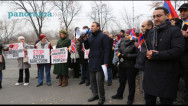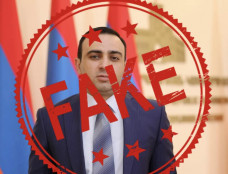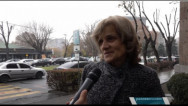
Video, which has recently appeared on Internet, confirms Azerbaijani armed forces’ involvement in Khojaly tragedy
Azerbaijani journalist Chingiz Mustafayev known for his shooting of military action in the region of the Karabakh conflict was one of those, who told the truth about Khojaly events. Mustafayev taped corpses of Khojaly residents found near the Azerbaijani positions not far from Aghdam in March 1992 and made public the information about the real perpetrators of Khojaly tragedy. Facts about Khojaly events in the video, which has recently appeared on the Net, confirm the Azerbaijani armed forces’ involvement in the tragedy.
“This program was not aired. They said this program was against soldiers of the national army or the President of the Supreme Council and so on. But there was only one reason. They knew that we would eventually introduce the program to people, no matter how difficult it might be. We had to know the truth,” Mustafayev said.
It is noted in the video that it is easy to examine how the Parliamentary Committee for Investigating the Khojaly tragedy operated.
“Committee has already completed its work. However, people will not be informed about the results owing to the same secret reasons, as the tragedy itself. We think they will never be informed because the eyewitnesses of the tragedy are no longer among us,” the voiceover in the video emphasizes.
It is also noted that according to the then chairman of Azerbaijan’s Popular Front Party and vice chairman of Supreme Council, Tamerlan Garayev, “if he unveiled everything he knew about Khojalу tragedy, even his tongue would be burnt.”
“However, unlike Garayev, Chingiz’s and his followers’ tongues are not burnt. As you know, Chingiz took shots of the tragedy twice and there are significant differences between the first and the second shootings.
The first time Chingiz visited the scene, he was the only journalist among others, who visited the place, but his presence had not been planned. Nobody knew he had got on the helicopter. At that time, soldiers had to bring only a few corpses from the scene.”
The photographed corpses from Khojaly were much closer to Aghdam. When Chingiz saw the people, who were walking among the corpses and escaped upon seeing the helicopter, he started to get suspicious. They were not Armenians.
“Several questions arise. How did those people get there without helicopter? Why and where were they taking the corpses? And if there was a road, why nobody protected these victims?”
The questions were very interesting. And maybe for the same reason, the helicopter that had accidently brought Chingiz to the scene, allegedly forgot him and found it necessary to leave him there.
This (2:03) is Chingiz’s first visit and first shooting. As you can see, the corpses are not mutilated. Here the bodies are just the way they were.
(2:10) This is the second visit organized to demonstrate the journalists from all over the world the “atrocities” of the Armenians. It was planned to show the conditions the civilians were in, allegedly because of the “Armenian bandits.”
Chingiz’s camera once again saw everything (2:23).
(2:24) And now, you see this poor man on the photo made for the first time.
And this is the photo made for the second time (2:29). But the same poor is scalped here.
Chingiz Mustafayev: “I took this photo yesterday in the afternoon, and there was nothing like this!” Mustafayev said.
Questions arise regarding who did it in one day. There are many unanswered questions of the kind.
Chingiz Mustafayev was killed on June 15, 1992. He was posthumously awarded the National Hero of Azerbaijan title for his shootings of the military action in the region of the Karabakh conflict. Chingiz Mustafayev is primarily known for his taping of the Khojaly residents’ corpses found near the Azerbaijani positions not far from Aghdam in January 1992.
He videotaped those corpses on March 2, 1992. When Mustafayev told Azerbaijan’s former president Ayaz Mutallibov that the bodies’ positions and the corpses’ injuries were not compatible with the initial inspection, the president told him “not to say a single word about it, otherwise, he would be killed.”
Newsfeed
Videos






























